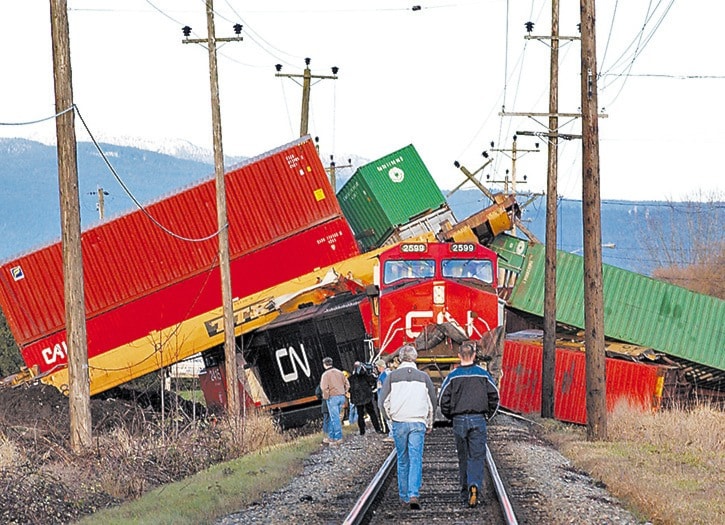Some time in April, the Township of Langley fire department will get its first report about the different types of hazardous goods that railway companies are moving through the community.
But the information may not be up-to-date and the fire department will not be allowed to make the specifics public.
“There is some concern about security,” fire chief Stephen Gamble told the March 3 meeting of Township council.
A written report presented by Gamble spells out the limitations of the safety directive issued by Transport Canada after the July 2013 Lac-Mégantic derailment that killed more than 40 people when an unattended freight train full of crude oil rolled down a hill, crashed and exploded.
The directive requires rail companies in Canada to “ … provide the designated Emergency Planning Official of each municipality through which dangerous goods are transported by railway vehicles with: yearly aggregate information on the nature and volume of dangerous goods … and any significant change to the information provided … as soon as practicable after the change occurs …”
However, the information will only be released to emergency planners who sign a non-disclosure statement that promises the information will be kept confidential “and used only for the purpose of emergency planning or response.”
Signing the statement gives access to an annual report “on the nature and aggregate volume of dangerous goods shipped through the municipality,” states an online information bulletin issued by Transport Canada and the Railway Association of Canada.
The report is supposed to include a breakdown of the amounts shipped every three months “to allow local first responders to identify trends and seasonal variations” the bulletin goes on to say.
Participating municipalities also have the right to contact railways operating in their community and request “preliminary information,” the bulletin adds.
The first annual reports to Canadian municipalities will be issued in April.
“It will be interesting to see what we get,” Gamble told council.
“We’re optimistic it will have some value for us.”
There are currently four rail companies operating in Langley; CNR, CPR, Southern Railway of BC and the BCR Port Subdivision.
Representatives of the rail companies have been invited to meet with the Township Community and Transportation Safety Advisory Committee.
The companies are also being asked to sit down with Langley response agencies like the fire department, police and ambulance services “to define authority, site priorities and communication linkages” the Gamble report says.
The report notes that there have been “numerous small incidents and two moderate incidents” involving derailments in the community.
The “moderate incidents” were a 1996 derailment in Glen Valley and a more recent crash on Glover Road.
On Dec. 23, 2002, a truck travelling south on Glover Road turned right (west) onto Smith Crescent, and was struck by a westbound CN container train.
Two of the train’s three engines derailed, and several of the container cars were scattered on the track and Glover Road.
No one was hurt, but the crash snarled pre-Christmas traffic, and closed Glover Road for more than 24 hours.
The derailment also caused power outages in the area, as power transmission lines along the track were knocked over by the impact. It took work crews three days to clear the track.
Currently, it’s known that small amounts of crude oil are being unloaded in Langley, and taken by tanker truck to the Chevron refinery in Burnaby. There is speculation the amount of oil shipped by rail will increase if proposed new pipelines are rejected.
Other chemicals that move on rail in the Lower Mainland region include chlorine, hydrochloric acid and sodium hydroxide, which spilled from CN Rail cars into the Cheakamus River in 2005, killing half a million fish.
In Langley, liquefied petroleum gas (propane) is transported on the CN mainline through Fort Langley, where homes are built close to both sides of the tracks.
Many people also live near the rail line in Walnut Grove.
Times achives show that 300,000 litres of ethylene dichloride were spilled in a Feb 15, 1986 train derailment near Fort Langley.
The site cleanup took more than four years, during which the chemical was vented into the air and contaminated groundwater was pumped into the Fraser river.
At the time, a spokesperson for the provincial environment ministry said the chemical, used to produce plastics, posed no “long-term” health hazard to humans.
— with files from Black Press
